Sphinginae subfamily
Sphingini tribe:
 |
This moth is a very strong flier, and make its way to
southern Arizona and southern California.
It is confirmed for Yavapai County and neighbouring counties. Might be present.
|
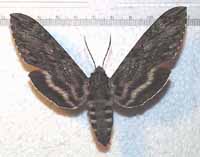 | The upperside of the forewing is dark gray with black and light gray
wavy lines. The upperside of the hindwing is black with a brownish
gray border and two white bands.
|
 |
Manduca quinquemaculatus
BAMONA,
the Five-spotted Hawkmoth.
Abdomen: usually has five but sometimes six pairs of yellow bands. Forewing is blurry brown and gray. Hindwing is banded with brown and white and has two
well-separated median zigzag bands. Fw fringes are grayish, not distinctly spotted with white.
|
 |
The abdomen of the adult moth has three pairs of yellow spots. The upperside of the forewing is yellowish brown to deep chocolate brown with a dusting of
white scales and zigzagged black and white lines.
|
 |
If you grow tomatoes, you have probably encountered it.
Larvae get very large and can strip a tomato plant.
|
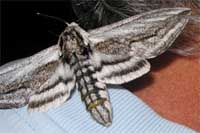 |
The upperside of the forewing has a wide white band along the costa
from base to apex. The remainder of the wing has black and white
bands.
|
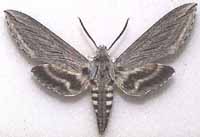 |
The upperside of the forewing is pale silver-gray with a series of
black dashes, a white patch at the tip, and a white stripe along the
outer margin. The upperside of the hindwing is black with blurry
white bands.
|
 |
Sphinx chersis
WO,
the Northern Ash Sphinx or Great Ash Sphinx
The upperside of the forewing is soft dark gray to blue-gray with a series of black dashes, one of which reaches
the wing tip. The upperside of the hindwing is black with blurry pale gray bands.
|
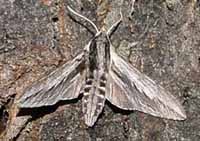 | Sphinx dollii (Wing span: 1 3/4 - 2 1/2 inches (4.5 - 6.3 cm)),
flies in arid brushlands and desert foothills from Nevada and
southern California east through Utah,
Arizona, Colorado, and New Mexico to Oklahoma and Texas.
|
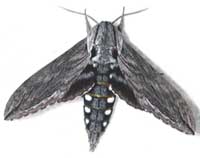 | The upperside of the forewing is pale blue-gray to dark gray with a black dash reaching the wing tip and
a white stripe along the lower outer margin.
The upperside of the hindwing is black with two diffuse white
bands, the upper one being practically non-existent.
|
 |
Sphinx vashti
BAMONA, the Snowberry Sphinx
The upperside of the forewing has a narrow black subterminal line
bordered by a white inverted V-shaped line on the outside, and a
black line running inwards from the apex of the wing.
It is most often found in montane woodlands and along streamcourses.
|
Smerinthini Tribe:
 |
This one is quite similar to Pachysphinx modesta, with modesta
being smaller and darker.
Moths should be on the wing from June-August.
|
 |
The outer margin of the forewing is quite wavy. There is a dark
cell spot and a dark oblique line mid wing from the costa almost
to the inner margin. Basic ground colour is pinkish brown.
Flight would be June-July. |
 |
Named for the small eye-spot in the hindwing, this moth has a wide
distribution.
|
 |
Smerinthus cerisyi
BAMONA, the Cerisyi's
Sphinx or One-eyed Sphinx, Larvae feed on poplars and willows.
Flight would be from late May-July as a single brood.
|
 |
This moth is widely distributed and fairly common.
Along the East Coast, it flies from P.E.I. to Florida. It is a surprise in Arizona.
|
Macroglossinae subfamily
Dilophonotini tribe:
 |
This species is reported in Yavapai County and in other southern
Arizona counties.
Males and females differ. Sometimes strays.
|
 |
During the night adults nectar at flowers, including bouncing bet
(Saponaria officinalis) and Asystasia gangetica beginning at dusk.
July and August are flight times in the southern states.
|
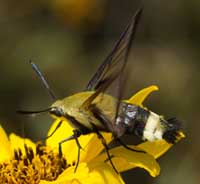 |
Hemaris thetis BAMONA, the Thetis Clearwing or Bee Hawk Moth,
The moth flies along forest edges and in meadows, gardens and
brushy fields. Day-flying adults nectar at lantana, dwarf bush honeysuckle,
snowberry, orange hawkweed, thistles, lilac, Canada violet, etc. Listed as diffinis on BAMONA.
|
Philampelini tribe:
 |
Eumorpha achemon larvae feed upon Grape (Vitis),
Virginia Creeper (Parthenocissus quinquefolia)
and other vines and ivies (Ampelopsis).
|
Macroglossini tribe:
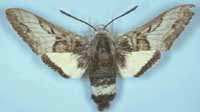 |
Euproserpinus wiesti adults fly, during the day, over sand washes
and prairie
blow-outs as a single brood from May-June.
|
 |
Hyles lineata
WO,
the White-lined Sphinx The white lines on the body and forewings are striking.
Even in flight, the broad pink area on the hindwings is visible.
Larvae can be quite varied.
|
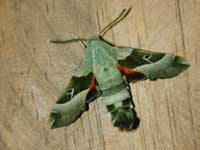 |
The upperside of the forewing is pale gray-green with a deep
green-brown median area and a white dash at the wing tip.
|
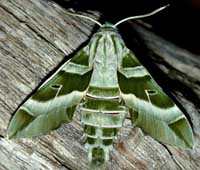 |
Jim Tuttle writes, "P. vega has a very large and dark basal
patch as the FW meets the thorax that is lacking in terlooii.
There are also three prominent longitudinal
stripes on the thorax of vega that are lacking in
terlooii."
|
|
|
